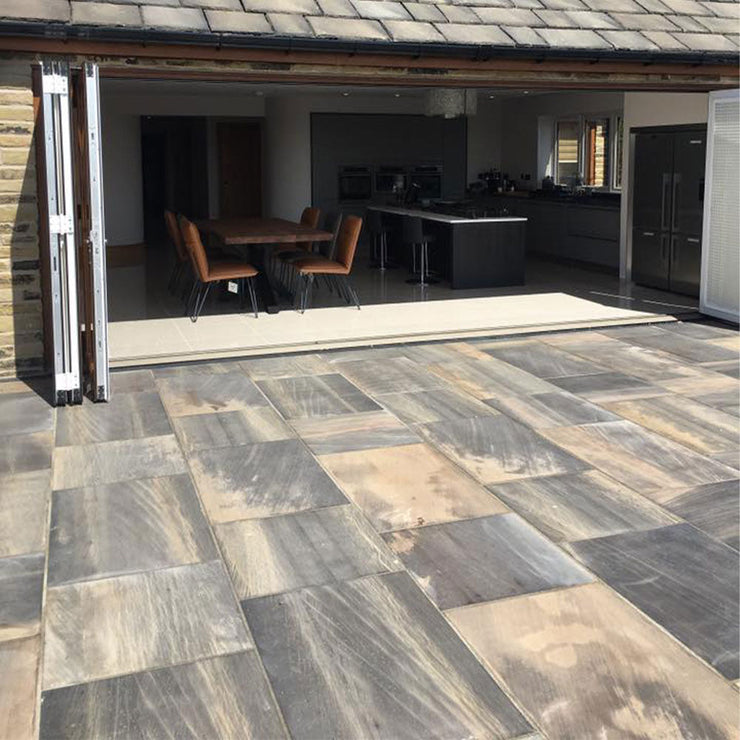
How do I remove the mud stains from my new porcelain patio tiles?
You've invested in a fresh porcelain patio, only to find it marked with stubborn mud stains after the first spell of bad weather. It’s a common issue, especially in UK gardens. The good news? Porcelain is far easier to clean than many other outdoor surfaces.
Unlike natural stone, which can soak up dirt and moisture, porcelain has a smooth surface that doesn’t hold on to stains easily. That said, knowing how to clean it properly makes all the difference.
Some methods can actually leave the tiles looking worse, while others work well but get overlooked. Today, Ovation Landscaping is here to walk through straightforward ways to deal with mud stains on porcelain.
What tools and materials do I need?
So, you’re wondering, ‘how do I remove mud stains from my new porcelain patio tiles?’ Will you need to take a trip to your local hardware shop? Potentially: have a look at our tools and materials list to find out:
- Soft-bristle broom or outdoor brush
- Leaf blower (optional for heavily shaded gardens)
- Plastic scraper or spatula
- Garden hose with adjustable nozzle
- Bucket
- Warm water
- pH-neutral detergent or mild soap
- White vinegar (optional)
- Baking soda (optional)
- Soft-bristle brush, sponge, or non-scratch cloth
- Pressure washer (low-pressure setting)
- Microfibre cloth or absorbent towel
- Porcelain-specific paving sealant (optional)
How to clean porcelain patio tiles
1. Sweep away loose debris
Begin by removing leaves, soil and fine grit using a soft‑bristle broom or leaf blower. Taking care at the beginning will prevent scratching when you scrub later.
2. Allow mud to dry, then scrape gently
If your porcelain paving slabs have visible mud stains, let them dry and then lift off as much as possible with a plastic scraper or spatula. Lifting them will minimise spreading across the slab surface.
3. Pre‑rinse the tiles
Use a garden hose to wet the surface and flush away fine grit. A quick pre-rinse should prime the surface for more effective cleaning.
4. Mix a mild cleaning solution
After scrubbing and pre-rinsing, it’s time to mix a mild cleaning solution.
Combine warm water with a few drops of pH‑neutral detergent or mild soap. For those harder-to-move stains, add a small amount of white vinegar or baking soda to the mixture.
5. Scrub gently with a soft brush or cloth
Once you’ve bathed your porcelain slabs in the solution, work it over using a soft‑bristle brush, sponge or clean cloth. Focus on stained areas without applying hard pressure, as heavy-handedness can damage the glazed surface.
6. For stubborn mud or grime, consider light, low‑pressure washing
Stubborn stains still visible? Next, grab your pressure washer.
You’ll want to keep it on the lowest setting, with the nozzle at least 30cm away. Don’t point the nozzle in one spot for too long; instead, use a sweeping motion to avoid pitting or damaging the grout joints.
7. Rinse thoroughly with clean water
Wash away all detergent suds and loosened dirt.
8. Dry the surface
Weather-provided, allow your porcelain slabs time to dry in the sun. You can also wipe them with a clean microfibre cloth or towel to avoid water spots.
9. Apply sealant if extra protection is needed (optional)
Despite being famously non-porous, you may want to choose a sealant formulated for porcelain to resist iron‑rich soil or algae staining, particularly in shaded or damp areas.
10. Repeat cleaning regularly
We recommend repeating these ten steps every few months, potentially sooner if stains keep appearing. Tackling marks before they become stains is a great way to prevent staining.

Mistakes to avoid
1. Using abrasive cleaners
Did you know that abrasive cleaners can leave ugly markings on porcelain? This includes abrasive cleansers (ones high in acidity) and tools (steel wool, hard-bristled or wire brushes, scouring pads or coarse scrubbers).
They can very easily scratch the glazed surface of porcelain tiles, weaken grout joints, and even leave behind particles that may rust over time. We highly recommend sticking to neutral pH solutions and softer-bristle brushes or cloths.
2. Not testing a small area
Always perform a spot test in a small place before applying any cleaning solution across your entire patio. Different porcelain finishes respond differently, and conducting this small test means you avoid damage on a broad scale.
3. Leaving cleaning agents on the surface
Manufacturers have strict application instructions for a reason. Do not allow cleaning products to sit on the tiles longer than recommended. Extended contact can leave streaks, residue, or haze on the surface.
Shop for porcelain patio tiles with Ovation Landscaping!
It’s time to bring your outdoor ideas to life.
Ovation Landscaping is your local supplier of top-quality porcelain paving slabs. Our products handle footfall, frost, salt and stains with ease, and right now, you could take advantage of our great value prices per square metre (and fast UK delivery).
FAQs
What is the best thing to clean porcelain tiles with?
The safest, most effective method of cleaning porcelain tiles is to use a pH‑neutral detergent or mild soap mixed with warm water. This solution should lift dirt without harming the porcelain glaze that makes these slabs so popular!
Can you pressure wash outdoor porcelain patio tiles?
Yes – but with the right approach. When used on a low-pressure setting and with a wide-angle or fan nozzle, a pressure washer can rinse away cleaning residue. Just keep a distance of at least 30cm, wash in sweeping motions and avoid focusing on grout joints.
How to get rust off porcelain patio tiles
Porcelain is non‑porous, so rust stains from metal furniture or plant pots usually do not penetrate.